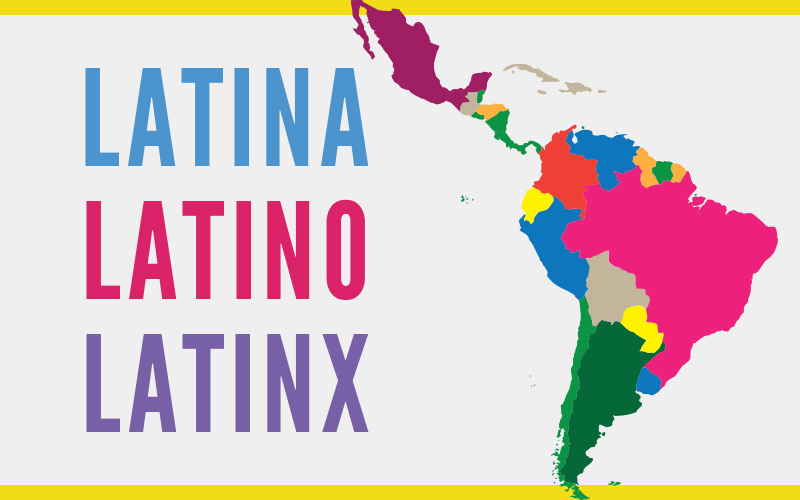I arrived in the United States at the age of eighteen to a university campus, which provided me, in addition to a solid liberal arts education, a crash course in American identity politics. I was a first year student in the early 1990s. Before Google or Urban Dictionary, I relied on dorm ice-breakers, student protests, and beer-keg banter to educate myself on the cultural differences across America and on the new terminology of public discourse. At the time, sensitivity to cultural differences had birthed the hyphenated identity — “Something-American” — and “Hispanic” was beginning to vie for space with the term “Latino”, which I immediately misunderstood.
Personally, I rarely felt a need for a blanket term to describe all of the people who hail from countries where Spanish is spoken, mainly because of the difficulty of the task: Spanish is spoken in so many diverse places. I called myself Colombian and as did other foreign-born students, while American-born friends would hyphenate their parents’ nationalities to their own. When conversations about peoples and politics would arise, the kinds of topics that inspire college papers and the late-night conversations of post-adolescents, I would use the word “Latin” in English and “latinoamericana” in Spanish.
Making a Case for the Basics
The process of revising my terminology began almost immediately. Using “Latin” worked for a while, because it was sort of neutral by virtue of being archaic, a reference to the roots of Spanish in the language in the long-defunct Roman empire. By my second year, I was taking more topical classes and needed greater precision in my language. “Latin” began to sound inauthentic to my ear, and so I thought to replace it with “Latina,” in my mind synonymous, in an autobiographical piece. “You are not Latina,” my favorite professor gently broke it to me, “you’re Hispanic.” What she meant, and most would agree with her, is that Latino is someone who grew up in the U.S. only, while Latin Americans require a different word.
For a year, I didn’t believe her, it didn’t make sense. Didn’t both words simply refer to a place of origin? Or was it the language? Asking these questions yielded many conversations with her and in my classes, now mostly small seminars. There I was able to hear the points of view of classmates who had been born into Hispanic communities in the U.S. Their experiences growing up rarely resembled mine, which had more in common with students from even distant countries like Romania or Thailand than with the American experience. Now I became familiar with the term “Chicano” as the more politically charged word for Mexican-Americans and I realized many of my Latino friends didn’t speak Spanish. I had grown up with the same language at home and in the world and they’d grown up under pressure to conform. I finally understood that “Latino” and “Hispanic” are not interchangeable and why we need options to describe our various experiences.
Where Did Hispanic Come From?
“Hispanic” was first used in the 1980s in the context of discovering how many people of Latin American origin were residing in the U.S. Before that time, there was no drive to quantify how many people with ties to Central and South American and the Spanish-speaking Caribbean islands were emigrating, and people simply referred to their individual origin, as I had as a new immigrant. But by the 80s there were enough diverse Hispanic populations living in the U.S. that they started to be grouped together, not only by the census-takers and the word, but by their very experience.
This similarity of experience was made evident by a popular phenomena that bridged the cultural gaps and long distances between different corners of the U.S.— television. Some have credited to Univision’s Cristina (the Spanish-language Oprah) specifically with giving representation, putting on stage families from different Hispanic cultures together to workshop problems they face in common.

Television programming in Spanish undoubtedly helped galvanize the larger Hispanic community and arrive at this umbrella term. There is nothing like watching a telenovela from a particular country to get a flavor of the folklore and see the common threads to ours. So must have been the mistaken idea that we are a race, rather than an ethnicity, which according to a 2010 census study, 37% of Hispanic people in the U.S believed. To think of our latinidad as something we’re born with would certainly bring us together. The word Hispanic then grew to replace clunky phrases like “people of Spanish-speaking descent” and presumably includes people still living in Latin America, immigrants, and their descendants.
There have been justifiable criticisms of the word Hispanic — it alludes to Spain and now that when we’ve grown aware of the erasure of native and African people when we invoke the colonizer along with the language they brought. The other edge of the same sword is that the linguistic division excludes places like Surinam, Guyana, Haiti, Caribbean islands where Spanish is not spoken, and the South American giant, Brazil. While these countries don’t share a language with Colombia, Cuba, and Argentina, they do share borders, rainforests and mountains, and many responsibilities, so experientially the category is artificial.
An unfair criticism is to call the term a government creation, as some have. The woman who came up with it, a bureaucrat called Grace Flores-Hughes, is herself Hispanic and was only attempting to shine a light on our population as a whole. Much less traceable are the origins of the word Latino, which in some spheres, like academia, is preferred over Hispanic. Notably though, a recent study showed that amongst Hispanics both in the U.S. and abroad, 50% of us have no preference either term, but those who do have a preference, overwhelmingly tend to choose “Hispanic.” Perhaps for its wider definition, the umbrella label “Hispanic” is many people’s choice for our population, whenever such an umbrella is necessary at all.
Enter “Latino”
On the other hand, “Latino” is a term that feels already politically charged, unwilling to engage with the colonial narrative, yet still calling back to the original language with its sound. There are places in the discourse in which we more often find “Latino” than any of the previous terms and it’s also useful in conjunction with other sections of our community that are usually left out of the mainstream, like Afro-Latino or Asian-Latino. In print, in both journalistic and academic formulations, “Latino” is preferred, especially in cases when our individual nationality/ethnicity is not appropriate.
The word has a lot going for it, the least of which is not its echo in Spanish. This Spanish-like ending tacked onto an English word defamiliarizes it, so that it takes the reader/listener perhaps a moment more to process, perhaps dwelling on the thought. But a Spanish ending also implies the grammatical problems of a Spanish ending, which for nouns, adjectives, and pronouns means we have to pick a gender. The birth of “Latina”, as the feminine form, came about quite naturally, and from that moment it was assumed that word would behave as in Spanish, with the plural — “Latinos” — which in Spanish, often reverts automatically to the masculine.

There is no doubt that this tendency, like calling multiple parents “padres”, is rooted in a long-ago paternalism of the language. Even other gendered languages (like Russian in which even past tense verbs carry gender), have a neuter. Spanish only has feminine and masculine genders. It also should be noted that Spanish gives excessive weight to a single individual of the male gender to turn an entire group masculine, such as when a group of 6 female friends and one male one go to the movies, todos ellos went to the movies. The inverse may be true but it’s not grammatical.
But,Who Runs the World?
Feminists for years have simply reversed the paradigm, using the feminine for singular and plural alike. Certainly, this choice is less clunky than stopping to include two genders at every mention (such as, los niños y las niñas). This double solution dilates everything too much, and while grammar should not be in the business of excluding anyone, inclusion should not be in opposition to style. And using a feminine default is one way to solve the gender binary problem without making clumsy sentences, but it doesn’t address the concerns members of the LGBTIQ community.

In an attempt to shed some of the machismo and accommodate, the gender solution of using the @ to replace the vowel began to appear in print. Visually, Latin@s appeals to me because it really does look like both the a and o are at the center of a hug. It has also been noted that the symbol is reminiscent of many native Central American cultures’ belief that we all of nature is embedded with both genders and their respect for the gift of individuals with gender fluidity in their community. Verbally, it is meant to be pronounced “Latinos, Latinas”, which I must assume is the reason that it fell out of favor almost as soon as it appeared. Language, after all, cannot be so different in its audio and its visual if it is to function properly.
Other solutions to the gender problem have including substituting the vowel with an “e” and, eventually, in 2015, the first appearance of Latinx. Pronounced as if it were spelled l-a-t-i-n-e-x, it has already been included in Merriam Webster’s and the Oxford English dictionaries as a non-gendered form of the word “Latino” preferred by non-binary people. It’s precursor in the OED is the salutation or honorifc “Mx.”, a non-gendered form of Mr. or Ms.
Getting Real About Grammar
The main criticism that the Latinx has received has been from grammar enthusiasts who object to the way the letter replacement would behave if it were in Spanish. In an excellent op-Ed in the L.A. Times, Daniel Hernandez drives the point home by extrapolating the x into all of the vowels it would replace in a regular sentence, aside from the “o” in “Latino”. What you get is a jumble of unpronounceable letters, once again that distention between the written and the oral, the membranes of grammatical structure straining to accommodate burgeoning identities. For Hernandez, greater is his desire to remain intelligible and clear than to apply an artifice to language, producing a clunky neologism to fit his sexuality.

Others won’t agree. To them, this recourse of x-ing out the need to define whether we are Latino or Latina is worth the extra time necessary to decode the message. There is something to the defamiliarization of language — for Berthold Brecht, the more difficult to comprehend the ideological message, the more political it becomes. Latinx could be an offshoot of his agitprop (agitation/propaganda) method. For feminists, Latina has been a good solution. Others stay classic and call themselves Latinos or Hispanic, and others yet stuck it out with the @ sign. For me (and it tickled me that Hernandez comes to a similar conclusion but for his very own reasons), I might be right back where I began, dropping that last spot altogether to become, once again, Latin.
For Image credit or remove please email for immediate removal - info@belatina.com






































